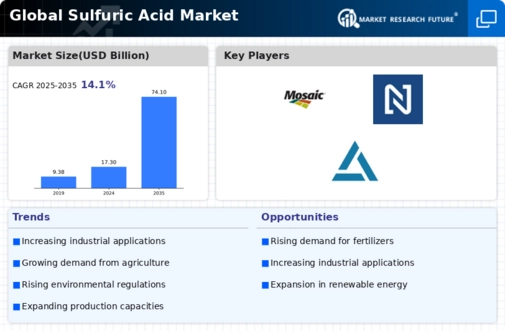Major market players are spending a lot of money on R&D to increase their product lines, which will help the Sulfuric Acid Market grow even more. Demand for sulfuric acid has been consistently growing owing to rapid growth in end-use industries. Substantial growth in population along with shrinking agricultural land across the globe is expected to elevate the demand for fertilizers and agrochemicals. Fertilizer industry is a key consumer of sulfuric acid. Thus, growing demand for fertilizers will eventually boost the growth of sulfuric acid market over the forecast period.
Similarly, rapid growth of the metal industry along with rising popularity of sulfuric acid as an extremely strong acid expected to create lucrative growth opportunities for the sulfuric acid manufacturers. The use of metals is increasing swiftly, owing to the substantial rise in demand from certain end-use industries including automotive, construction, and various others.
The global sulfuric acid industry is highly fragmented. The key players operating in the Sulfuric Acid Market include BASF SE (Germany), OCP Group S.A (Morocco)., The Mosaic Company (US), Nouryon (Netherland), PVS Chemicals Inc (US), Aurubis (Germany), Ineos Enterprises Limited (UK), Oriental Carbon & Chemicals Ltd. (India), Amal Ltd. (India), Dexo Fine Chem Pvt. Ltd. (India) and many more. The market players are focused on investing in research & development and adopting strategic growth initiatives such as expansion, product launches, agreement, partnership, acquisition, and merger to strengthen their market position and capture a large customer base.
These players have adopted strategies such as joint ventures, and expansions to enhance their business revenue and market share. Expansion of production units globally is the key strategy adopted by these players to cater to the increasing demand for sulfuric acid. Several companies are following investment and expansion strategies to strengthen their production capacities and penetrate into the emerging markets. An increase in the number of H2SO4 manufacturers & suppliers is projected to boost market growth over the forecast period.
Induron Protective Coatings announced the release of Novasafe, their newest product, in 2023. Novasafe is a thick-film, ceramic-filled, furfuryl modified novolac epoxy that is resistant to the worst conditions seen in treatment facilities. In comparison to typical epoxies, Novasafe's formulation chemistry is unique in the market and allows it to perform what treatment plant operators need in the most harsh settings with one fewer layer and a thinner film than polyurethane/polyurea. Novasafe's special resin and filler package allows it to achieve this.
In 2019, the completion of LANXESS's sulfuric acid plant in Leverkusen, which is not only the company's oldest manufacturing site but also one of the most advanced in Europe. This location has been producing chemicals for 125 years that are still required in many facets of production and daily life.
In Jiaxing, China, BASF opened a new electronic-grade sulfuric acid (H2SO4) plant in 2018 to cater to the nation's expanding semiconductor manufacturing sector. The plant has begun its expansion phase to double its production capacity before the facility is finished, driven by the increased demand from customers.
BASF SE: BASF SE (BASF) is one of the leading chemical producers in the world. Its portfolio is organized into six segments, namely, chemicals, materials, industrial solutions, surface technologies, nutrition & care, and agricultural solutions. The company has an extensive regional presence. It has subsidiaries and joint ventures in more than 80 countries and operates 390 production sites in Europe, Asia-Pacific, North America, and Africa. BASF has customers across more than 190 countries and supplies products to a range of industries. BASF's Catalysts division is the world's leading supplier of environmental and process catalysts.
The group offers exceptional expertise in the development of technologies that protect the air we breathe, produce the fuels that power our world and ensure efficient production of a wide variety of chemicals, plastics and other products, including advanced battery materials. The company operates four sulfuric acid plants at its headquarters in Ludwigshafen, in Germany, where the latest catalyst technologies are used.
OCP Group: OCP Group is one of the world’s largest custodian and supplier of phosphate-based fertilizers and associated products for soil health and a leader in applied science and education. Its mission is to provide customized plant nutrition solutions for healthy food production. OCP Group is a fertiliser company engaged in the extraction and distribution of phosphate-based fertiliser products. Founded in 1920, OCP Group is 95% owned by the state of Morocco, with 25% of the country’s total exports being OCP Group’s phosphates.
The company’s leading market position is helped by having access to more than 70% of the world's phosphate reserves. OCP Group facilitates more than 30 subsidiaries and joint ventures and serves more than 160 client groups across five continents.













